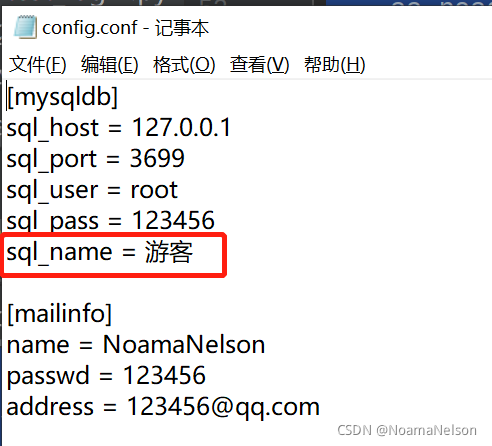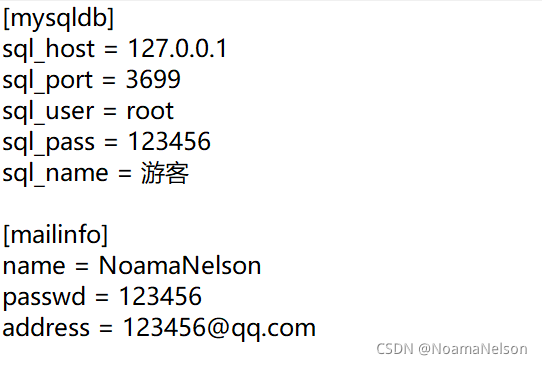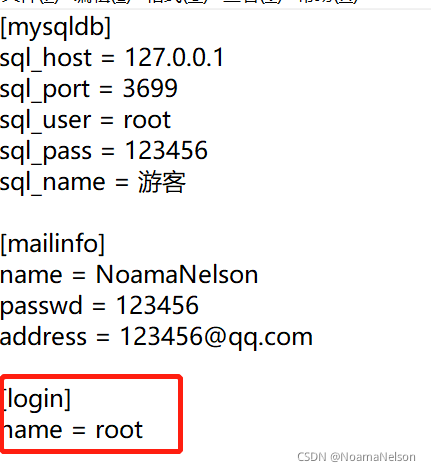目录
- 1 configparser安装
- 2 configparser简介
- 3 表示方法
- 4 configparser详细使用
- 4.1 对象初始化
- 4.2 获取所有的sections
- 4.3 获取所有的sections对应的options
- 4.4 read方法和get方法,获取指定section下的option值
- 4.5 items方法,获取指点section所用配置信息
- 4.6 set和write方法,修改某个option的值
- 4.7 has_section和has_option方法
- 4.8 add_section方法,添加section和option
- 4.9 remove_section和remove_option方法,删除section和option
- 5 configparser常见的异常
- 6 本文所有源码
1 configparser安装
pip3 install configparser
2 configparser简介
- 用来读取配置文件的python包;
- 一般做自动化测试的时候,会使用到这个模块,用来封装一些常量。比如数据库、邮件、用户名密码、项目常量等等;
- 这个使用根据个人喜好和项目来确定,不一定一定要使用这个模块,也可以使用其它的方法做配置,比如py文件、xml、excel、yaml、json等等。
- configparser源码大约1360行左右,通读源码可有效了解该模块的使用。本文只做简单介绍常用的方法。
3 表示方法
- 新建一个名为
conf.py文件; - 写入如下数据,格式如下:
[mysqldb]
sql_host = 127.0.0.1
sql_port = 3699
sql_user = root
sql_pass = 123456
[mailinfo]
name = NoamaNelson
passwd = 123456
address = 123456@qq.com
4 configparser详细使用
4.1 对象初始化
- 写入如下代码,把对象初始化。
# -*- coding:utf-8 -*-
# 作者:NoamaNelson
# 日期:2021/11/19
# 文件名称:conf.py
# 作用:configparser模块的使用
# 联系:VX(NoamaNelson)
# 博客:https://blog.csdn.net/NoamaNelson
import configparser
import os
class Conf:
def __init__(self):
self.conf = configparser.ConfigParser()
self.root_path = os.path.dirname(os.path.abspath(__file__))
self.f = os.path.join(self.root_path + "/config.conf")
self.conf.read(self.f)
4.2 获取所有的sections
def read_sections(self):
print(f"1、获取所有的sections:{self.conf.sections()}")
if __name__ == "__main__":
aa = Conf()
aa.read_sections()
- 结果为:
D:\Python37\python.exe F:/python_study/conf.py
1、获取所有的sections:['mysqldb', 'mailinfo']
4.3 获取所有的sections对应的options
def read_options(self, s1, s2):
print(f"2、获取mysqldb所有的options:{self.conf.options(s1)}")
print(f"3、获取mailinfo所有的options:{self.conf.options(s2)}")
if __name__ == "__main__":
aa = Conf()
aa.read_sections()
aa.read_options("mysqldb", "mailinfo")
- 结果为:
D:\Python37\python.exe F:/python_study/conf.py
1、获取所有的sections:['mysqldb', 'mailinfo']
2、获取mysqldb所有的options:['sql_host', 'sql_port', 'sql_user', 'sql_pass']
3、获取mailinfo所有的options:['name', 'passwd', 'address']
4.4 read方法和get方法,获取指定section下的option值
read是读取配置文件,如self.conf.read(self.f)是读取指定config.conf文件;get是获取具体的值;
def read_conf(self, m, n):
name = self.conf.get(m, n) # 获取指定section的option值
print(f"4、获取指定section:{m}下的option:{n}的值为{name}")
if __name__ == "__main__":
aa = Conf()
aa.read_sections()
aa.read_options("mysqldb", "mailinfo")
aa.read_conf("mysqldb", "sql_host")
- 结果为:
D:\Python37\python.exe F:/python_study/conf.py
1、获取所有的sections:['mysqldb', 'mailinfo']
2、获取mysqldb所有的options:['sql_host', 'sql_port', 'sql_user', 'sql_pass']
3、获取mailinfo所有的options:['name', 'passwd', 'address']
4、获取指定section:mysqldb下的option:sql_host的值为127.0.0.1
4.5 items方法,获取指点section所用配置信息
def get_items(self, m, n):
print(f"5、获取sectoion:{m}下的配置信息为:{self.conf.items(m)}")
print(f"6、获取sectoion:{n}下的配置信息为:{self.conf.items(n)}")
if __name__ == "__main__":
aa = Conf()
aa.read_sections()
aa.read_options("mysqldb", "mailinfo")
aa.read_conf("mysqldb", "sql_host")
aa.get_items("mysqldb", "mailinfo")
- 结果为:
D:\Python37\python.exe F:/python_study/conf.py
1、获取所有的sections:['mysqldb', 'mailinfo']
2、获取mysqldb所有的options:['sql_host', 'sql_port', 'sql_user', 'sql_pass']
3、获取mailinfo所有的options:['name', 'passwd', 'address']
4、获取指定section:mysqldb下的option:sql_host的值为127.0.0.1
5、获取sectoion:mysqldb下的配置信息为:[('sql_host', '127.0.0.1'), ('sql_port', '3699'), ('sql_user', 'root'), ('sql_pass', '123456')]
6、获取sectoion:mailinfo下的配置信息为:[('name', 'NoamaNelson'), ('passwd', '123456'), ('address', '123456@qq.com')]
4.6 set和write方法,修改某个option的值
- 如果option不存在则创建它;
def set_option(self, m, n, s):
self.conf.set(m, n, s)
self.conf.write(open(self.f, "w"))
print(f"7、设置setion:{m}下的option:{n}的值为:{s}")
if __name__ == "__main__":
aa = Conf()
aa.read_sections()
aa.read_options("mysqldb", "mailinfo")
aa.read_conf("mysqldb", "sql_host")
aa.get_items("mysqldb", "mailinfo")
aa.set_option("mysqldb", "sql_name", "游客")
- 结果为:
D:\Python37\python.exe F:/python_study/conf.py
1、获取所有的sections:['mysqldb', 'mailinfo']
2、获取mysqldb所有的options:['sql_host', 'sql_port', 'sql_user', 'sql_pass']
3、获取mailinfo所有的options:['name', 'passwd', 'address']
4、获取指定section:mysqldb下的option:sql_host的值为127.0.0.1
5、获取sectoion:mysqldb下的配置信息为:[('sql_host', '127.0.0.1'), ('sql_port', '3699'), ('sql_user', 'root'), ('sql_pass', '123456')]
6、获取sectoion:mailinfo下的配置信息为:[('name', 'NoamaNelson'), ('passwd', '123456'), ('address', '123456@qq.com')]
7、设置setion:mysqldb下的option:sql_name的值为:游客
- 因为之前的配置文件中没有
sql_name,所以会新创建它,如果创建的内容存在,直接修改对应的值;

4.7 has_section和has_option方法
has_section方法检查对应的section是否存在;has_option方法检查对应的option是否存在;
def has_s_o(self, s, o):
print(f"8、检查section:{s}是否存在:{self.conf.has_section(s)}")
print(f"9、检查section:{s}下的option:{o}是否存在:{self.conf.has_option(s, o)}")
if __name__ == "__main__":
aa = Conf()
aa.read_sections()
aa.read_options("mysqldb", "mailinfo")
aa.read_conf("mysqldb", "sql_host")
aa.get_items("mysqldb", "mailinfo")
aa.set_option("mysqldb", "sql_name", "游客")
aa.has_s_o("mysqldb", "sql_name")
- 结果为:
D:\Python37\python.exe F:/python_study/conf.py
1、获取所有的sections:['mysqldb', 'mailinfo']
2、获取mysqldb所有的options:['sql_host', 'sql_port', 'sql_user', 'sql_pass', 'sql_name']
3、获取mailinfo所有的options:['name', 'passwd', 'address']
4、获取指定section:mysqldb下的option:sql_host的值为127.0.0.1
5、获取sectoion:mysqldb下的配置信息为:[('sql_host', '127.0.0.1'), ('sql_port', '3699'), ('sql_user', 'root'), ('sql_pass', '123456'), ('sql_name', '游客')]
6、获取sectoion:mailinfo下的配置信息为:[('name', 'NoamaNelson'), ('passwd', '123456'), ('address', '123456@qq.com')]
7、设置setion:mysqldb下的option:sql_name的值为:游客
8、检查section:mysqldb是否存在:True
9、检查section:mysqldb下的option:sql_name是否存在:True
4.8 add_section方法,添加section和option
-
add_section:添加section; -
添加前:

def add_s_o(self, s, o, v):
if not self.conf.has_section(s):
self.conf.add_section(s)
print(f"10、添加新的section为{s}")
else:
print(f"10、添加新的section为{s}已经存在,无需添加!")
if not self.conf.has_option(s, o):
self.conf.set(s, o, v)
print(f"11、要添加的option为{o}, 值为{v}")
else:
print(f"11、要添加的option为{o}, 值为{v},已经存在,无需添加!")
self.conf.write(open(self.f, "w"))
if __name__ == "__main__":
aa = Conf()
aa.read_sections()
aa.read_options("mysqldb", "mailinfo")
aa.read_conf("mysqldb", "sql_host")
aa.get_items("mysqldb", "mailinfo")
aa.set_option("mysqldb", "sql_name", "游客")
aa.has_s_o("mysqldb", "sql_name")
aa.add_s_o("login", "name", "root")
- 添加后:
D:\Python37\python.exe F:/python_study/conf.py
1、获取所有的sections:['mysqldb', 'mailinfo']
2、获取mysqldb所有的options:['sql_host', 'sql_port', 'sql_user', 'sql_pass', 'sql_name']
3、获取mailinfo所有的options:['name', 'passwd', 'address']
4、获取指定section:mysqldb下的option:sql_host的值为127.0.0.1
5、获取sectoion:mysqldb下的配置信息为:[('sql_host', '127.0.0.1'), ('sql_port', '3699'), ('sql_user', 'root'), ('sql_pass', '123456'), ('sql_name', '游客')]
6、获取sectoion:mailinfo下的配置信息为:[('name', 'NoamaNelson'), ('passwd', '123456'), ('address', '123456@qq.com')]
7、设置setion:mysqldb下的option:sql_name的值为:游客
8、检查section:mysqldb是否存在:True
9、检查section:mysqldb下的option:sql_name是否存在:True
10、添加新的section为login
11、要添加的option为name, 值为root

- 再次运行代码,会提示已经存在:
10、添加新的section为login已经存在,无需添加!
11、要添加的option为name, 值为root,已经存在,无需添加!
4.9 remove_section和remove_option方法,删除section和option
def remove_s_o(self, s, o):
if self.conf.has_section(s):
self.conf.remove_section(s)
print(f"12、删除section:{s}==OK!")
else:
print(f"12、要删除的section:{s}不存在,不用删除!")
if self.conf.has_option(s, o):
self.conf.remove_option(s, o)
print(f"13、删除section:{s}下的option:{o}==OK!")
else:
print(f"13、要删除的section:{s}下的option:{o}不存在,不用删除!")
if __name__ == "__main__":
aa = Conf()
aa.read_sections()
aa.read_options("mysqldb", "mailinfo")
aa.read_conf("mysqldb", "sql_host")
aa.get_items("mysqldb", "mailinfo")
aa.set_option("mysqldb", "sql_name", "游客")
aa.has_s_o("mysqldb", "sql_name")
aa.add_s_o("login", "name", "root")
aa.remove_s_o("login", "name")
- 结果为:
D:\Python37\python.exe F:/python_study/conf.py
1、获取所有的sections:['mysqldb', 'mailinfo', 'login']
2、获取mysqldb所有的options:['sql_host', 'sql_port', 'sql_user', 'sql_pass', 'sql_name']
3、获取mailinfo所有的options:['name', 'passwd', 'address']
4、获取指定section:mysqldb下的option:sql_host的值为127.0.0.1
5、获取sectoion:mysqldb下的配置信息为:[('sql_host', '127.0.0.1'), ('sql_port', '3699'), ('sql_user', 'root'), ('sql_pass', '123456'), ('sql_name', '游客')]
6、获取sectoion:mailinfo下的配置信息为:[('name', 'NoamaNelson'), ('passwd', '123456'), ('address', '123456@qq.com')]
7、设置setion:mysqldb下的option:sql_name的值为:游客
8、检查section:mysqldb是否存在:True
9、检查section:mysqldb下的option:sql_name是否存在:True
10、添加新的section为login已经存在,无需添加!
11、要添加的option为name, 值为root,已经存在,无需添加!
12、删除section:login==OK!
13、要删除的section:login下的option:name不存在,不用删除!
5 configparser常见的异常
| 异常 | 描述 |
|---|---|
| ConfigParser.Error | 所有异常的基类 |
| ConfigParser.NoSectionError | 指定的section没有找到 |
| ConfigParser.DuplicateSectionError | 调用add_section() 时,section名称已经被使用 |
| ConfigParser.NoOptionError | 指定的参数没有找到 |
| ConfigParser.InterpolationError | 当执行字符串插值时出现问题时,出现异常的基类 |
| ConfigParser.InterpolationDepthError | 当字符串插值无法完成时,因为迭代次数超过了最大的范围,所以无法完成。InterpolationError的子类 |
| InterpolationMissingOptionError | 当引用的选项不存在时,会出现异常。InterpolationError的子类 |
| ConfigParser.InterpolationSyntaxError | 当产生替换的源文本不符合所需的语法时,就会出现异常。InterpolationError的子类。 |
| ConfigParser.MissingSectionHeaderError | 当试图解析一个没有分段标题的文件时,会出现异常。 |
| ConfigParser.ParsingError | 当试图解析文件时发生错误时,会出现异常 |
| ConfigParser.MAX_INTERPOLATION_DEPTH | 当raw参数为false时,get()的递归插值的最大深度。这只适用于ConfigParser类 |
6 本文所有源码
# -*- coding:utf-8 -*-
# 作者:NoamaNelson
# 日期:2021/11/19
# 文件名称:conf.py
# 作用:configparser模块的使用
# 联系:VX(NoamaNelson)
# 博客:https://blog.csdn.net/NoamaNelson
import configparser
import os
class Conf:
def __init__(self):
self.conf = configparser.ConfigParser()
self.root_path = os.path.dirname(os.path.abspath(__file__))
self.f = os.path.join(self.root_path + "/config.conf")
self.conf.read(self.f)
def read_sections(self):
print(f"1、获取所有的sections:{self.conf.sections()}")
def read_options(self, s1, s2):
print(f"2、获取mysqldb所有的options:{self.conf.options(s1)}")
print(f"3、获取mailinfo所有的options:{self.conf.options(s2)}")
def read_conf(self, m, n):
name = self.conf.get(m, n) # 获取指定section的option值
print(f"4、获取指定section:{m}下的option:{n}的值为{name}")
def get_items(self, m, n):
print(f"5、获取sectoion:{m}下的配置信息为:{self.conf.items(m)}")
print(f"6、获取sectoion:{n}下的配置信息为:{self.conf.items(n)}")
def set_option(self, m, n, s):
self.conf.set(m, n, s)
self.conf.write(open(self.f, "w"))
print(f"7、设置setion:{m}下的option:{n}的值为:{s}")
def has_s_o(self, s, o):
print(f"8、检查section:{s}是否存在:{self.conf.has_section(s)}")
print(f"9、检查section:{s}下的option:{o}是否存在:{self.conf.has_option(s, o)}")
def add_s_o(self, s, o, v):
if not self.conf.has_section(s):
self.conf.add_section(s)
print(f"10、添加新的section为{s}")
else:
print(f"10、添加新的section为{s}已经存在,无需添加!")
if not self.conf.has_option(s, o):
self.conf.set(s, o, v)
print(f"11、要添加的option为{o}, 值为{v}")
else:
print(f"11、要添加的option为{o}, 值为{v},已经存在,无需添加!")
self.conf.write(open(self.f, "w"))
def remove_s_o(self, s, o):
if self.conf.has_section(s):
self.conf.remove_section(s)
print(f"12、删除section:{s}==OK!")
else:
print(f"12、要删除的section:{s}不存在,不用删除!")
if self.conf.has_option(s, o):
self.conf.remove_option(s, o)
print(f"13、删除section:{s}下的option:{o}==OK!")
else:
print(f"13、要删除的section:{s}下的option:{o}不存在,不用删除!")
if __name__ == "__main__":
aa = Conf()
aa.read_sections()
aa.read_options("mysqldb", "mailinfo")
aa.read_conf("mysqldb", "sql_host")
aa.get_items("mysqldb", "mailinfo")
aa.set_option("mysqldb", "sql_name", "游客")
aa.has_s_o("mysqldb", "sql_name")
aa.add_s_o("login", "name", "root")
aa.remove_s_o("login", "name")
『全栈测试技术,分享,共勉,共进,提升』
